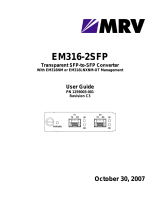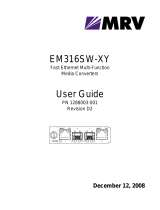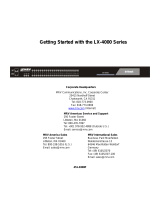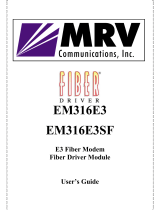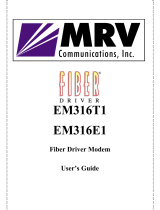Page is loading ...

EM316EDFA-BR
Erbium Doped Fiber Amplifier Booster
EM316EDFA-LPR
Erbium Doped Fiber Inline Pre-Amplifier
User Guide
1294008-001
Revision D2
January 28, 2008

Fiber Driver
®
EM316EDFA User Guide
P/N 1294008-001 Rev D2 i
Table of Contents
1 Preliminary Considerations ..............................................................iii
1.1 Trademarks...................................................................................................................................................iii
1.2 Copyright.......................................................................................................................................................iii
1.3 Customer Support.........................................................................................................................................iii
1.4 Compliance ...................................................................................................................................................iv
1.5 General Safety .............................................................................................................................................. v
1.5.1 Cautions and Warnings ......................................................................................................................... v
1.5.2 Laser Safety........................................................................................................................................... v
1.5.3 Laser Device Classifications..................................................................................................................vi
1.5.4 Static Electricity ....................................................................................................................................vii
1.5.5 Workplace Preparation .........................................................................................................................vii
1.6 About This Manual ...................................................................................................................................... viii
1.7 Latest Revision and Related Documents.................................................................................................... viii
2 Introduction to EM316EDFA Optical Amplifiers................................ 1
2.1 Features........................................................................................................................................................ 2
2.1.1 EM316EDFA-BR / EM316EDFA-LPR Monitored Parameters .............................................................. 2
2.1.2 EDFA Control Inputs.............................................................................................................................. 2
2.1.3 EDFA Alarm Outputs ............................................................................................................................. 2
3 Preparation and Installation.............................................................. 3
3.1 Unpacking the Fiber Driver Module .............................................................................................................. 3
3.2 Front Panel.................................................................................................................................................... 4
3.3 LEDs ............................................................................................................................................................. 4
3.4 DIP Switches................................................................................................................................................. 4
3.5 Module Installation ........................................................................................................................................ 5
4 EDFA Features................................................................................. 7
4.1 Network Management Control and Monitoring ............................................................................................. 7
4.1.1 Management Control from the Network ................................................................................................ 8
4.1.2 EM316EDFA Alarm Output Pins ........................................................................................................... 8
4.1.3 Operating Parameters ........................................................................................................................... 8
5 Module Management........................................................................ 9
5.1 Serial Console Interface.............................................................................................................................. 10
5.2 EM316LNXNM-OT Command Line Interface (CLI) .................................................................................... 11
5.2.1 EM316LNXNM-OT Boot and CLI Login .............................................................................................. 12
5.2.2 CLI Navigation ..................................................................................................................................... 13
5.2.3 Login Context Commands and Examples ........................................................................................... 14
5.2.3.1 “show version”..........................................................................................................14
5.2.3.2 “show log” ..................................................................................................................14
5.2.3.3 “show running-config”...........................................................................................15
5.2.3.4 “show startup-config”...........................................................................................16
5.2.3.5 Configuring System Parameters ...................................................................................17

Fiber Driver
®
EM316EDFA User Guide
P/N 1294008-001 Rev D2 ii
5.2.4 Chassis Context .................................................................................................................................. 18
5.2.4.1 “show”...........................................................................................................................18
5.2.4.2 Other Commands..........................................................................................................19
5.2.5 Slot Context Commands and Examples.............................................................................................. 20
5.2.5.1 “?” .................................................................................................................................21
5.2.5.2 “list”...........................................................................................................................22
5.2.5.3 “show”...........................................................................................................................23
5.2.6 Port Context Commands and Examples ............................................................................................. 26
5.2.6.1 “?” .................................................................................................................................27
5.2.6.2 “list”...........................................................................................................................29
5.2.6.3 “show”...........................................................................................................................30
5.2.6.4 “port description” .................................................................................................31
5.2.7 Displaying and Saving System Parameters ........................................................................................ 32
5.2.8 Restoring Default Parameters ............................................................................................................. 33
6 Appendix......................................................................................... 34
6.1 Technical Specifications ............................................................................................................................. 34
6.2 Troubleshooting .......................................................................................................................................... 34
Table of Figures
Figure 1 -- EM316EDFA optical amplifier applications ......................................................................................... 1
Figure 2 -- Unpacking............................................................................................................................................ 3
Figure 3 -- EM316EM316EDFA-BR / EM316EDFA-LPR Front Panel.................................................................. 4
Figure 4 -- Remove the required blank panels...................................................................................................... 5
Figure 5 -- Module installation (not all chassis are shown) ................................................................................... 6
Figure 6 -- Fiber Driver module installed in a powered chassis............................................................................ 6
Figure 7 -- EM316LNXNM-OT general commands for EDFA modules .............................................................. 11
Figure 8 – EM316LNXNM-OT slot context commands for EDFA modules ........................................................ 20
Figure 9 – EM316LNXNM-OT port context commands for EDFA modules........................................................ 26

Fiber Driver
®
EM316EDFA User Guide
P/N 1294008-001 Rev D2 iii
1 Preliminary Considerations
1.1 Trademarks
All trademarks are the property of their respective holders.
1.2 Copyright
MRV Communications reserves the right to change technical specifications or documentation in
order to improve reliability, function, or design. Exercise discretion in using this document. The user
assumes sole responsibility for applying the information supplied herein.
Copyright © 2007 by MRV Communications. All rights reserved.
1.3 Customer Support
Before contacting customer support, look for software updates, technical specifications, and
frequently asked questions (FAQ) online at the MRV support website:
http://service.mrv.com.
The website includes information regarding software updates, technical specifications, and
frequently asked questions (FAQ) as well as contact information.
Contact help online by sending email to
[email protected] or through the website request link at
http://service.mrv.com/support/forms/supportcall.cfm
For direct MRV customer support by telephone, call your local sales representative, system
engineer, or one of the following numbers.
+1-800-435-7997
MRV Americas
(US, Canada, and Latin America)
+1-978-952-4888
MRV Europe +49-6105-2070
MRV International +972-4-993-6200
Include the following important information when opening a support case.
• Site ID or company name
• Contact information
• Model or product name
• Serial number
• Top assembly revision (see label on board)
• Brief problem or question including a description of the host network environment
• Attenuation data for applicable high-speed fiber links
• Urgency of the issue

Fiber Driver
®
EM316EDFA User Guide
P/N 1294008-001 Rev D2 iv
1.4 Compliance
Contact your sales representative for more regulatory compliance information regarding specific
MRV products or product families.
Fiber Driver Chassis
FCC Part 15 (Class A); IC (Class A); EMC Directive: Emission (Class A) and Immunity; LVD
Directive: Electrical Safety; CE Marking; TUV CUE Mark (Canada, USA, EU); GOST; RoHS
Directive, WEEE Directive: Wheelie Bin Mark; ETSI, NEBS, C-Tick
Fiber Driver Modules
FCC Part 15 (Class A); IC (Class A); EMC Directive: Emission (Class A) and Immunity; LVD
Directive: Electrical Safety; RoHS Directive, WEEE Directive: Wheelie Bin Mark; ETSI
Optical and Copper Transceivers
FCC Part 15 (Class A); IC (Class A); EMC Directive: Emission (Class A) and Immunity; LVD
Directive: Electrical Safety; CE Marking; TUV; UL, CSA, RoHS Directive, ETSI, NEBS, compliant
with EN 60825-1/A1:2002 Safety of Laser Products

Fiber Driver
®
EM316EDFA User Guide
P/N 1294008-001 Rev D2 v
1.5 General Safety
1.5.1 Cautions and Warnings
Disconnect all power from electronic devices before servicing. Some equipment may have
multiple power cords requiring disconnection.
1.5.2 Laser Safety
WARNING: Fiber optic equipment may emit laser or infrared light that can injure your
eyes. Never look into an optical fiber or connector port. Always assume that fiber optic
cables are connected to a laser light source.
CAUTION: Do not install or terminate fibers when a laser may be active.
WARNING: Never look directly into a live optical fiber. Always wear appropriate laser
safety glasses when working with open fiber cables that might be connected to an
operational laser transmitter. Direct open fibers ends away from faces.
CAUTION: Use of controls or adjustments or performing procedures other than those
specified herein may result in hazardous radiation exposure.
If a fiber optic laser device output is recognized as a higher than Class 1 product (Class 1M, for
example), the device is evaluated, labeled, and certified by TUV. Class 1 and 1M outputs are
not considered hazardous, but laser safety practices should always be observed.
A fiber optic transceiver emits either single-mode or multi-mode light into a fiber optic strand.
Take the following precautions when handling optical fibers.
• Wear safety glasses when you install optical fibers.
• Be aware of the risk of laser radiation exposure.
• Always assume that fiber optic cables are active because transmitted light is invisible to
the human eye.
• Never look directly into a beam (T
X
part of a transmitter) or open fiber ends. The invisible
light can damage your eyes.
• Place optical fibers in a safe location during installation.
• Protect optical fiber connectors with clean dust caps for safety and sanitation.
• Follow the manufacturer instructions when using optical test equipment.

Fiber Driver
®
EM316EDFA User Guide
P/N 1294008-001 Rev D2 vi
1.5.3 Laser Device Classifications
Laser devices of class 1M, class 2, class 2M and class 3R
Precautionary measures are only necessary to avoid a permanent direct looking into the laser
beam; for classes 2 and 2M is a momentary (0.25 sec.) irradiation in a wave length range
between 400 nm and 700 nm, as it may occur when you accidentally look into the beam, not
considered to be dangerous. However, you should not level the laser beam intentionally at
people. The use of optical aids (e.g. binoculars) together with laser devices of the classes 1M,
class 2M and class 3R may increase the danger for the eyes

Fiber Driver
®
EM316EDFA User Guide
P/N 1294008-001 Rev D2 vii
1.5.4 Static Electricity
Eliminate static electricity in the workplace by grounding operators, equipment, and devices
including components and computer boards. Grounding prevents static charge buildup and
electrostatic potential differences. Transporting products in special electrostatic shielding
packages reduces electrical field damage potential.
1.5.5 Workplace Preparation
A safe and effective workplace provides the following items.
• ESD protective clothing/smocks: Street clothing must not come in contact with components
or computer boards since the various materials in clothing can generate high static charges.
ESD protective smocks, manufactured with conductive fibers, are recommended.
• Electrostatic shielding containers or totes: These containers (bags, boxes, etc.) are made of
specially formulated materials, which protect sensitive devices during transport and storage.
• Antistatic or dissipative carriers: These provide ESD protection during component movement
in the manufacturing process. It must be noted that antistatic materials alone will not provide
complete protection. They must be used in conjunction with other methods such as totes or
electrostatic shielding bags.
• Dissipative tablemat: The mat should provide a controlled discharge of static voltages and
must be grounded. The surface resistance is designed such that sliding a computer board or
component across its surface will not generate more than 100 V.
• Operator grounding: Keep a wrist strap or ESD cuff in constant contact with bare skin with a
cable for attaching it to the ESD ground. The wrist strap drains off the static charge of the
operator. The wrist strap cord has a current-limiting resistor for personnel safety. Wrist straps
must be tested frequently to ensure that they are undamaged and operating correctly. Use
special grounding heel straps or shoes when a wrist strap is impractical. These items are
effective only when used in conjunction with a dissipative floor.
• ESD protective floor or mat: The mat must be grounded through a current-limiting resistor.
The floor or mat dissipates the static charge of personnel approaching the workbench.
Special conductive tile or floor treatment can be used when mats are not practical or cause a
safety hazard. Chairs should be conductive or grounded to the floor with a drag chain.

Fiber Driver
®
EM316EDFA User Guide
P/N 1294008-001 Rev D2 viii
1.6 About This Manual
Document Number: P/N 1294008-001 Rev D2
Document: EM316EDFA-BR / EM316EDFA-LPR User Guide
Release Date: January 28, 2008, 4:26:01 PM
1.7 Latest Revision and Related Documents
The latest revision of MRV documents may be found at:
http://www.mrv.com
Release Notes for Fiber Driver modules are produced as required.
EM316LNXNM-OT User Guide: Software-generated manual for EM316LNXNM-OT Network
Management module usage describing the command line interface (CLI) and commands.
MegaVision User Manual: Graphical network management system for Fiber Driver modules and
other SNMP manageable products and IP devices using MRV Communication’s MegaVision Pro®
Network Management System.

Fiber Driver
®
EM316EDFA User Guide
P/N 1294008-001 Rev D2 1
2 Introduction to EM316EDFA Optical Amplifiers
The fiber optic amplifier module is used to increase an optical signal for extended range or clarity
without electrical conversion circuitry. The MRV EM316EDFA modules boost an optical input up to 20
decibels. The amplifier also has a bandwidth of 40 nm, making it suitable for use in wavelength
division multiplexing (WDM) applications as an optical spectral amplifier. The module may be
controlled from the network through the MRV EM316LNXNM-OT Network Manager Module.
Optical amplifiers operate in different modes, depending upon their position in the optical link. The
EM316EDFA is available in two configurations to fill the necessary roles in your network.
EM316EDFA-BR
C-band optical amplifier booster
C-band in-line optical amplifier
EM316EDFA-LPR
C-band pre-amplifier
The example below illustrates how the EM316EDFA optical amplifiers fit into an optical link.
Figure 1 -- EM316EDFA optical amplifier applications
EM316EDFA-BR is used as long haul booster module in combination with an EM316EDFA-LPR inline
pre-amplifier.

Fiber Driver
®
EM316EDFA User Guide
P/N 1294008-001 Rev D2 2
2.1 Features
The EM316EDFA board can run in standalone mode without any input from a management
module. The EM316EDFA analog input power determines the output power because the module
runs at a fixed gain.
EM316EDFA status is reported through SNMP through a network management module as well as
by LEDs on the front panel.
The green “SD” LED on the front panel indicates input greater than the thresholds corresponding to
the EDFA module type, as indicated in the table below.
EM316EDFA-BR -8 dBm
EM316EDFA-LPR -30 dBm
A green LED at front panel (Optical Output) indicates output power greater than -10 dBm.
The module temperature is measured from 0
o
C to 70
o
C and reported to management. To protect
against excessive heat, the laser shuts down when measured temperature reaches 70
o
C.
2.1.1 EM316EDFA-BR / EM316EDFA-LPR Monitored Parameters
• Input power and output power readings
• Output gain reading
• Case temperature reading
• Amplifier status reading
• Alarm status
o case temperature
o loss of input power
o loss of output power
2.1.2 EDFA Control Inputs
• Software reset
• Output power mute
2.1.3 EDFA Alarm Outputs
• Case temperature
• Loss of input
• Loss of output

Fiber Driver
®
EM316EDFA User Guide
P/N 1294008-001 Rev D2 3
3 Preparation and Installation
3.1 Unpacking the Fiber Driver Module
Follow these steps with reference to the figure below.
Step 1. Open the cardboard box
Step 2. Remove the static bag containing the device.
Step 3. Check for additional accessories in the box that may move beneath the module tray
during transit.
In the unlikely event that any package content is missing, contact an authorized MRV dealer or
representative. If it becomes necessary to return the shipment, repackage the unit in its original
box.
Figure 2 -- Unpacking

Fiber Driver
®
EM316EDFA User Guide
P/N 1294008-001 Rev D2 4
3.2 Front Panel
Figure 3 -- EM316EM316EDFA-BR / EM316EDFA-LPR Front Panel
3.3 LEDs
PWR/NMS Power
On – DC +5V power is applied to the card
SD Input Optical Power
On – Input signal greater than the input threshold
setting
OPTICAL OUTPUT OK
Output Optical Power
On – Output power is greater than -2 dBm, for apc
mode or -10 dBm for agc mode
3.4 DIP Switches
The EM316EDFA-BR is pre-configured in booster mode. There are no user-selectable switches.
The EM316EDFA-LPR is pre-configured in inline pre-amplifier mode. There are no user-selectable
switches to operate either inline or as a pre-amplifier.
The DIP switch block at the underside of the module has six switches. Only switch 6 affects
operation of the amplifier module. Use switch 6 to enable or disable network management.
Switch # Function Setting
1-5 N/A Reserved
6 Management Enable Default: ON = enable management

Fiber Driver
®
EM316EDFA User Guide
P/N 1294008-001 Rev D2 5
3.5 Module Installation
EM316xx cards are hot-swappable in a powered Fiber Driver chassis. Install the EM316xx module
by aligning the edge of the card with the rail of the chassis slot. Hand-tighten the thumb screw. Do
not over-tighten.
The thumb screw is on the left when installed in the BU-1, BU-2, BU-3, and BU-4 chassis. The
thumb screw is on the bottom when installed in the BU-16 chassis.
3.5.1.1.1 Tools
• 6-inch Phillips #1 screwdriver (for some module screws)
• 6-inch flat-tip 5.0 screwdriver
3.5.1.1.2 Procedure
Follow all guidelines to eliminate static electricity while handling the module and other electronic
devices. Refer to the front of this manual for some safety suggestions.
Step 1 Remove the blank panel or old module from the target chassis slot. Unfasten the
mounting screws with a 6-inch Phillips screwdriver, or disengage any thumb screws by hand.
Figure 4 -- Remove the required blank panels
To comply with FCC regulations and for optimal cooling air flow, a cover panel or a module must
cover every chassis slot. To limit external signals, no chassis slot should remain open when the
unit is operational. Secure modules and panels with appropriate screws for grounding and
further compliance.

Fiber Driver
®
EM316EDFA User Guide
P/N 1294008-001 Rev D2 6
Step 2 Install the module into a Fiber Driver chassis by aligning the edge of the card with the rail
of the chassis. Tighten the thumbscrew by hand.
Figure 5 -- Module installation (not all chassis are shown)
Handle modules by the edges to avoid damaging any components. Follow all ESD precautions
listed at the front of this manual. Use your thumb to push the module securely into the chassis slot.
Do not use excessive force, but make sure the module connector is fully inserted in the chassis.
Secure the module by hand using the thumbscrew.
Figure 6 -- Fiber Driver module installed in a powered chassis

Fiber Driver
®
EM316EDFA User Guide
P/N 1294008-001 Rev D2 7
4 EDFA Features
While operating correctly in an appropriate environment, EM316EDFA optical amplifier modules
require minimal operator intervention. However, because these devices are critical to network
infrastructure, administrative monitoring of these devices is essential for early fault detection.
EM316EDFA modules report simple status visually with front panel LEDs. More detailed diagnostic
data is available remotely through the EM316LNXNM-OT module management interfaces discussed
in the next section.
4.1 Network Management Control and Monitoring
The following EM316EDFA features are managed with an EM316LNXNM-OT network
management module.
Control
• Disable amplifier output
Read amplifier module temperature
Read optical input power
Read optical output power
Monitoring
Read amplifier power supply voltage
Temperature
Input power
Output power
Alarms
Common alarm

Fiber Driver
®
EM316EDFA User Guide
P/N 1294008-001 Rev D2 8
4.1.1 Management Control from the Network
• Output power or gain control
• Power or gain control limits
• Input power and output power readings
• Output gain reading
• Case temperature reading
• Alarm status including case temperature, loss of input power, loss of output power
• Amplifier status reading
• Software reset
• Output power mute
4.1.2 EM316EDFA Alarm Output Pins
• Case temperature
• Loss of input
• Loss of output
4.1.3 Operating Parameters
Automatic Gain Control (AGC) maintains a constant gain for the module. The tables below show
the constant operating parameters of each EDFA module type.
Thresholds
EM316EDFA-BR EM316EDFA-LPR
Module Function
Booster
In-line /
Preamplifier
Input Threshold
-8 dBm -30 dBm
Input Shutdown
-10 dBm -32 dBm
Output Threshold
-10 dBm -10 dBm
Small Signal Gain
9 dBm 25 dBm
Output Power
0 to 18 dBm 0 to15.5 dBm
Recommended Operating Conditions
EM316EDFA-BR EM316EDFA-LPR
Input signal dynamic range -10 to +9 dBm -20 to +5 dBm
Output optical power range 0 to 18 dBm 0 to +15.5 dBm
Optical bandwidth 1528 t o1563 nm 1528 t o1563 nm

Fiber Driver
®
EM316EDFA User Guide
P/N 1294008-001 Rev D2 9
5 Module Management
Most Fiber Driver modules, including the EDFA amplifier family, may be managed by a Fiber Driver
network management (NM) module installed in the same chassis.
The EDFA amplifier modules may be managed by the EM316LNXNM-OT Network Management (NM)
module.
The NM module installs in the same chassis as the managed modules. It provides management for
the EDFA amplifier module and other compatible Fiber Driver modules resident in the chassis. Refer
to specific module documentation to determine compatibility with a specific NM.
Factory settings work in most EDFA amplifier installations, but network management through an NM
module is recommended for local and remote- system status monitoring. Network environments are
unpredictable, and Fiber Driver network management is a critical tool for proactive administration as
well as for reduced operating expenses.
The NM provides a command line interface (CLI), accessible either through a local serial port and
console or from the IP network using a terminal emulation environment. Some CLI commands specific
to the EDFA amplifier modules in a managed environment are discussed in this section. Refer to the
appropriate NM documentation (EM316LNXNM-OT) for further details regarding the interface and
commands specific to your installation.
The network management module also provides Simple Network Management Protocol (SNMP)
support to allow control through any industry standard network management system (NMS). To
maximize the graphical remote management control of Fiber Driver modules, MRV offers
MegaVision® Pro. It is a unique and full-featured NMS with graphical user interfaces (GUI) for all
managed MRV network components including Fiber Driver. A limited version of MegaVision called
“Configurator” is available for trial through the MRV website (
http://www.mrv.com). Refer to MegaVision
Pro documentation for more information on the benefits offered with the product.

Fiber Driver
®
EM316EDFA User Guide
P/N 1294008-001 Rev D2 10
5.1 Serial Console Interface
After the network management (NM) module is installed, power up the chassis and attach the
serial RS-232 cable to the PC or terminal device. Configuring terminal emulation software on the
PC is beyond the scope of this document. The components below may be ordered from MRV.
• Adapter (part number 350-0308 REV-B MRG/20028-2)
• Cable (part number 151-3028 REV-F AI 04/04)
The NM has at least one Ethernet port, which is typically used to connect to a Local Area Network
(LAN). The factory default IP address is 192.168.14.201 with netmask 255.255.255.0, sometimes
written as 192.168.14.201/24 to show the 24 bits masked for subnetting. The default gateway
address is 192.168.14.1/24.
From the network, connect to the NM IP address using telnet or SSH (secure shell) to open the
command line interface (CLI). Telnet services are disabled by default on the EM316LNXNM-OT,
but they may be enabled for additional CLI access.
Each NM has an RS-232 interface that is used for serial communications to the CLI. This
connection is recommended for network setup. Besides configuration simplicity, it offers the
advantage of “out-of-band” management for greater network autonomy.
Configure the EM316LNXNM-OT RS-232 serial parameters with the following values.
RS-232
Serial Port
Parameters
• • 38400 baud
• • 8 data bits
• • 1 stop bit
• • no parity
• • no flow control

Fiber Driver
®
EM316EDFA User Guide
P/N 1294008-001 Rev D2 11
5.2 EM316LNXNM-OT Command Line Interface (CLI)
The EM316LNXNM-OT provides command line interface (CLI), SNMP, and graphical
administration options for a Fiber Driver chassis system. This section introduces the CLI for the
Linux-based network management (EM316LNXNM-OT) module.
EM316LNXNM-OT management commands are specific to each module.
The EM316LNXNM-OT management module also includes MegaVisionJ, a built-in graphical
interface to manage only the Fiber Driver chassis system controlled by the specified NM. This
graphical system is accessible from any standard Java-enabled web browser that can reach the IP
address assigned to the EM316LNXNM-OT. MegaVisionJ allows remote management of the entire
Fiber Driver chassis system and compatible modules.
Some commands applicable to the EDFA amplifier modules or host chassis are illustrated in this
manual. The box below lists a few of the sample commands addressed in this document. Refer to
the Table of Contents for a list of commands addressed here, and refer to EM316LNXNM-OT
documents for more detail.
show
?
list
show config
show defaults
description <name>
Figure 7 -- EM316LNXNM-OT general commands for EDFA modules
Some of these commands apply to both slot-level and port-level contexts as described in the
navigation portion of this section. Refer to EM316LNXNM-OT documentation for a more complete
discussion of the Linux-based interface and available commands.
/
